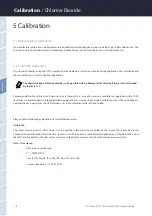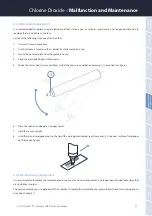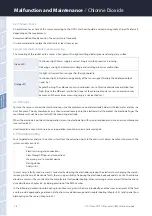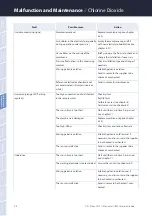
18
Us
e
Us
e
Calibr
ation
Calibr
ation
M
alfunc
tion and
M
ain
tenanc
e
M
alfunc
tion and
M
ain
tenanc
e
Comm-
issioning
Comm-
issioning
In
tr
oduc
tion
In
tr
oduc
tion
G
ener
al
Inf
or
ma
tion
G
ener
al
Inf
or
ma
tion
FA
Q
FA
Q
Technical
Da
ta
Technical
Da
ta
W
ar
ran
ty
W
ar
ran
ty
Cust
omer
ser
vic
e
Cust
omer ser
vic
e
Con
tac
t
Con
tac
t
Key
w
or
d
Inde
x
Key
w
or
d
Inde
x
Ac
cessor
ies
Ac
cessor
ies
D01-915en201911 Manual eCHEM Chlorine Dioxide
Malfunction and Maintenance
//
Chlorine Dioxide
6.2.3 Sensor Check
An adjustment or a check of the sensor according to the DPD-1 method should be carried out regularly at specific intervals,
depending on the requirements.
Recommendation: Weekly control, if necessary more frequently.
It is recommended to replace the electrolyte at least twice a year.
Sensors with digital internal signal processing
The mounting of the socket on the sensor is transparent. Two light emitting diodes (green and orange) are visible:
Green LED
Continuous light: Power supply is correct. Program in the processor is running.
Flickering or no light: Indicates low voltage and resulting processor malfunction.
Orange LED
No light: (all correct) Sensor signal has the right polarity.
Continuous light: indicates wrong polarity of the sensor signal. Multiply the displayed output
signal by -1.
Regular flashing: The chlorine sensor is overloaded. Cause: Chlorine dioxide concentrations too
high. (Due to the different sensitivities/slopes of the chlorine dioxide sensors, an overdrive may
occur even if the maximum measuring range is not reached yet.)
6.2.4 Storage
To store the sensor, unscrew the membrane cap, rinse the membrane cap and electrode holder with clean water and dry in a
dust-free place. The dry membrane cap is then screwed loosely onto the electrode shaft to protect the electrode finger. The
membrane must not be in contact with the measuring electrode.
When the electrode is put back into operation, clean the electrode tip with special sandpaper and use a new membrane cap
(see section 6.2.2).
Used membrane caps, which were once in operation, cannot be stored and reused again.
6.3 Troubleshooting
For a targeted error analysis, the entire system from the extraction point to the drain must always be taken into account. The
system usually consists of:
• Sensor
•
Electrical wiring and connections
•
Flow-through fittings and connections
•
Measuring and / or control device
•
Dosing device
•
Analysis kit
In most cases, a faulty measurement is corrected by cleaning the electrode, replacing the electrolyte or changing the memb-
rane cap. In the case of electronic faults, there is no possibility of repairing the electrode body adequately on site. The chlorine
dioxide sensor must be sent back to the manufacturer for troubleshooting. When returning a sensor, always follow the proce-
dure described in chapter 6.4, including provision of the RMA number.
In the following, detailed troubleshooting instructions are given, which are intended to enable a clear assessment of the fault
and to provide appropriate guidance. A distinction is made between general troubleshooting (chapter 6.3.1) and special trou-
bleshooting on the sensor (chapter 6.3.2).






























